


Then at high water bring your boat in to the area and lean it against the wall or piles, with adequate fendering in place. You would need to be well prepared in advance so that you have everything you need ready onboard.įirst check out the area at low water where you want to do the job to make sure there are no surprises like a big lump of rock in the wrong place. We have a few of these coming so we can test them out for you.If you keep your boat in an area where there is a large tidal range, you could try drying out against a wall, or against piles and doing the job at low water between the outgoing tide and the next incoming tide. Expands after insertion to hold in place.Twist and compress by hand to insert into the hole.They help hold it more securely in place.They help Sta-Plug® conform to the hole near the edge where a tight fit is most crucial.These riblets offer two big advantages over traditional straight-edged emergency plugs:
#Stay afloat emergency leak sealant series#
Different by design, Sta-Plug’s® shape includes a series of concentrically larger riblets stepped along the length of the cone. The riblets help Sta-Plug® conform to the shape of the hole, sealing a leak near the edge where a tight fit is crucial, and holding the plug more securely in place. Unique edge gripping riblets help hold the plugin a hole, keeping water out. A soft cone-shaped design allows it to easily fill the irregular shapes of hull impact breaches, as well as any round hole leak from a hose or thru-hull. Sta-Plug® is Forespar’s form-fitting emergency plug. We do not really want to play with this bully but since we have no choice, we may as well set some “ground rules” (no pun intended)… We can use grounding plates for this but in most cases, this will be our keel. We then need to “persuade” this strike to follow a path in order for the electrical charge to exit our vessel in a controlled manner. For most of us, the lightning rod is our mast. There is no guarantee it will, but the law of probability says that the strike will seek a high point which is geographically isolated. It acts as the focal point for lightning to strike. Invented by Benjamin Franklin in 1752, the lightning rod plays an important part in our lightning mitigation strategy. This path should be the shortest, most direct route possible. This is often installed at the manufacturing stage but can be fitted retrospectively. The power is then conducted into the water via adequately sized cables in an attempt to carry the electricity through a path of least resistance towards the water. With a grounded system, your yacht has a lightning arrester to focus the strike’s point of impact. Those that have a grounding system and those that do not. In the context of lightning mitigation, there are two types of yachts. The fact is, that most lightning-related boating deaths occur on small open motorboats. The last myth is something we can be happy about which is the myth that a yacht with a mast is more dangerous.Perhaps the idiom “a bolt from the blue” says it all… Lightning could strike more than 4 kilometres from a visible thunderstorm. It is not raining so we are safe… Not necessarily.So apply first aid immediately following the DRSABCD system. Well, no… There is no way a human can hold electrical charge large enough to present a danger to others. Don’t touch a lightning victim or you will be electrocuted.It doesn’t mean you are safe if the yacht next to you is 10 meters taller… It can hit a newspaper stand next to a skyscraper… Saying this, height and isolation are the dominant factors in whether lightning will strike an object. It can hit a park bench 5 meters away from a telegraph pole. As a sailor, you may be somewhat relieved that lightning is indiscriminate and it can strike anywhere. Another myth is that lightning only strikes the tallest object around.He was hit by lightning seven times and survived all of them. Perhaps you think the myth relates more to people not getting struck twice? If so, then think of Roy Sullivan, US park ranger in Virginia. The Empire State Building is on average struck by lightning more than 20 times per year. Let’s start with the most used myth of all.


 0 kommentar(er)
0 kommentar(er)
